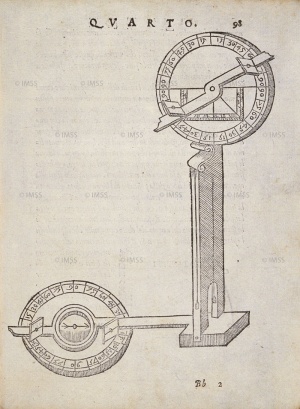Vertical Compass
From Inventions
| (2 intermediate revisions not shown) | |||
| Line 1: | Line 1: | ||
{{Template invention | {{Template invention | ||
| - | |nome= | + | |nome= |
| + | Name currently used to distinguish this instrument from the simpler [[Surveying Compass | surveying compass]]. | ||
| - | |descrizione= | + | |descrizione= Instrument probably derived from the [[polymeter]], and even earlier from the [[torquetum]]. In the version of Walther Riff (1547, III), a vertical goniometric disk divided around the edge into 360° and equipped with diopter and shadow square is mounted on a revolving rod at the centre of a horizontal goniometric circle (see [[compass]]). In a variant by Cosimo Bartoli (1564, IV), the rod is attached at right angles above the diopter of the horizontal circle and has an opening at the base similar to that of Regiomontanus’s torquetum (1544). While the horizontal circle serves to measure the position angles, the vertical one is used to measure distances in order to perform surveying from a single station. The diopter of the vertical circle is also essential when the station is situated on a height from which places could not be sighted with the diopter of the horizontal one. |
|inventore= Walther Riff | |inventore= Walther Riff | ||
| Line 21: | Line 22: | ||
|strumentiesistenti= | |strumentiesistenti= | ||
| + | - Musée des arts et métiers, Paris<br> | ||
| + | [http://cugnot.cnam.fr:8000/SEARCH/BASIS/collec/internet/objet/DDW?W%3DDESIG+PH+WORDS+%27boussole+verticale%27+ORDER+BY+DESIG/Ascend%26M%3D1%26K%3D23740%26R%3DY%26U%3D1 Paris, Musée des arts et metiers, inv. 40441-0000-] <br /> | ||
| + | [http://cugnot.cnam.fr:8000/SEARCH/BASIS/collec/internet/objet/DDW?W%3DDESIG+PH+WORDS+%27boussole+verticale%27+ORDER+BY+DESIG/Ascend%26M%3D2%26K%3D38740%26R%3DY%26U%3D1 Paris, Musée des arts et metiers, inv. 09949-0006-] <br /> | ||
| + | [http://cugnot.cnam.fr:8000/SEARCH/BASIS/collec/internet/objet/DDW?W%3DDESIG+PH+WORDS+%27boussole+verticale%27+ORDER+BY+DESIG/Ascend%26M%3D3%26K%3D38739%26R%3DY%26U%3D1 Paris, Musée des arts et metiers, inv. 09949-0005-] <br /> | ||
|link= | |link= | ||
Current revision as of 13:29, 7 September 2010
Name currently used to distinguish this instrument from the simpler surveying compass.
Contents |
Inventor
Walther Riff
Historic Period
1547
Description
Instrument probably derived from the polymeter, and even earlier from the torquetum. In the version of Walther Riff (1547, III), a vertical goniometric disk divided around the edge into 360° and equipped with diopter and shadow square is mounted on a revolving rod at the centre of a horizontal goniometric circle (see compass). In a variant by Cosimo Bartoli (1564, IV), the rod is attached at right angles above the diopter of the horizontal circle and has an opening at the base similar to that of Regiomontanus’s torquetum (1544). While the horizontal circle serves to measure the position angles, the vertical one is used to measure distances in order to perform surveying from a single station. The diopter of the vertical circle is also essential when the station is situated on a height from which places could not be sighted with the diopter of the horizontal one.
Bibliographical Resources
Bartoli, Cosimo. Del modo di misurare le distantie…,ms., 1559, Firenze, Biblioteca Medicea Laurenziana, Ms. Plut. 30.27.
Bartoli, Cosimo. Del modo di misurare le distantie, le superficie, i corpi, le piante, le provincie, le prospettive, et tutte le altre cose terrene, che possono occorrere a gli uomini, secondo le vere regole d'Euclide, et de gli altri più lodati scrittori. In Venetia, per Francesco Franceschi Sanese, 1564, IV.
Regiomontanus, Johannes. Scripta clarissimi mathematici M. Ioannis Regiomontani, De torqueto, astrolabio armillari, regula magna Ptolemaica, baculoque astronomico, et observationibus cometarum, aucta necessariis Ioannis Schoneri Carolostadii additionibus, item Ioannis de Monteregio et Bernardi Waltheri observationes motuum solis, ac stellarum tam fixarum, cumque erraticarum, item libellus Georgii Purbachii de Quadrato geometrico…, Norimbergae, apud Ioannem Montanum & Ulricum Neuber, 1544.
Ryff, Walther. Der furnembsten, notwendigsten, der gantzen Architectur angehörigen Mathematischen und Mechanischen künst eygentlicher Bericht und vast klare, verstendliche unterrichtung, Nürnberg, Johan Petreius, 1547, III.
Existing Instruments
- Musée des arts et métiers, Paris
Paris, Musée des arts et metiers, inv. 40441-0000-
Paris, Musée des arts et metiers, inv. 09949-0006-
Paris, Musée des arts et metiers, inv. 09949-0005-
Images
Author of the entry: Filippo Camerota

